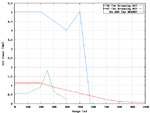claidemore
Senior Airman
Beau-FIGHTER? Designed as an interim replacement until the Whirlwind could be fully developed, and classified as a "heavy fighter". Started it's career as a night fighter, then fighter/bomber, and eventually went on to be used in the anti-shipping role.
The four 20mm Hispano cannons on the Beau were in the nose, the six .303s were in the wings, four on one side, two on the other (outboard of the engines). The Mosquito MkII had four 20mm plus four .303, all mounted in the nose, giving it an even tighter concentration of fire, albeit with two less machine guns.
The Mk21 Beaufighter had four x 20mm (nose) and four x .50 Brownings (in the wings). That's pretty hard to beat.
The four 20mm Hispano cannons on the Beau were in the nose, the six .303s were in the wings, four on one side, two on the other (outboard of the engines). The Mosquito MkII had four 20mm plus four .303, all mounted in the nose, giving it an even tighter concentration of fire, albeit with two less machine guns.
The Mk21 Beaufighter had four x 20mm (nose) and four x .50 Brownings (in the wings). That's pretty hard to beat.


